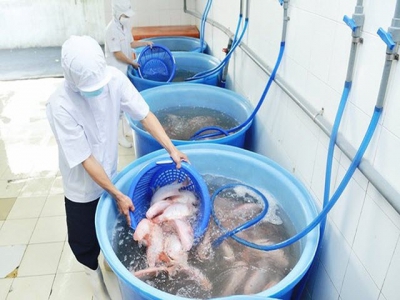Difficulties hold back aquatic exports

Aquatic product export was estimated to touch US$644 million in the first month of this year, a decrease of 3.9 percent compared to the same period last year, of which pangasius fish exports dropped 4.4 percent and shrimps declined 2.2 percent. Therefore, the export target of $10 billion or a growth of 11 percent for aquatic industry this year is unlikely to be feasible.
Workers prepare red tilapia fish for processing for exporting to the EU and South Korea. (Photo: SGGP)
According to Mr. Truong Dinh Hoe, general secretary of the Vietnam Association of Seafood Exporters and Producers (VASEP), the aquatic industry has been facing three main difficulties.
The first one is material source. Control on material source about illegal, unreported and unregulated (IUU) fishing and chemical residues remains poor, causing producers to be unable to synchronously control production process.
Meanwhile, fish feed production depends on imported materials including corn and soy beans, thus the prices of fish feed are always higher than those of other countries, affecting cost prices of input materials of aquatic product processing companies, reducing their competitiveness compared to Thailand, India and Ecuador.
Not to mention that negative impacts of climate change, saline intrusion and epidemic diseases caused a shortage of material that factories had to import material so as to meet processing demand.
The second difficulty is market barrier. The EU’s IUU carding system has increased difficulty in exporting seafood into the European market. As for the US market, anti-dumping tax on shrimps and pangasius fish, catfish inspection program and the latest seafood import monitoring program have become great pressure on seafood export of Vietnam.
Besides that there are other difficulties. Mr. Tran Van Dung, director of Basea Foods Ba Ria - Vung Tau Company which imports aquatic raw material for processing for many years, said that there are some items that the company imports annually but they receive the same control as new items, causing longer shipping time.
Mr. Dung proposed that post-customs clearance inspection should be done every year instead of five years because such prolongation will make it difficult for firms to implement production.
Mr. Tran Van Linh, chairman of Thuan Phuoc Seafood and Trading Corporation in Da Nang, said that the Government should take action in projecting shrimp farming areas for provinces and irrigation program for shrimp farming.
Theoretically, farmers and fishermen are immune from value added tax, but oil which accounts for 50 percent of farming cost is charged environmental fees. Although shrimp farmers do not have to pay tax for shrimp feed, they still have to pay for environmental fees, value added tax for veterinary drugs and transportation fees. The Government should quickly resolve these shortcomings to create favorable conditions for agriculture to thrive.
According to Mr. Ngo Van Ich, chairman of VASEP, aquatic industry posted a growth of 6 percent last year, much lower than its true potential as shrimp, the main export product, has not showed it full potential and advantages when shrimp exports merely reached $3.6 billion, a drop of 8 percent compared to that in 2017. Aquatic industry possibly posts a growth of 10 percent per annum and a growth of 12 percent per annum in the most favorable condition.
Minister Nguyen Xuan Cuong of the Ministry of Agriculture and Rural Development said that export target of $10 billion or 11 percent increase compared to last year for aquatic industry was rather high but it was reasonable as the target was calculated based on market potential of three main products. Of which, shrimp exports target $4.2 billion. As a key export product, the completion of its plan of shrimp industry will help aquatic industry to move closer to its target of $10 billion.
Pangasius fish has overcome its crisis period, achieving $2.2 billion in exports last year compared to $1.8 billion in 2017. Therefore, a goal of $2.3 billion in pangasius fish exports is feasible.
With determination to remove the so-called IUU Regulation yellow card of the EU, seafood exports is expected to rake in $3.5 billion this year as it still posted positive growth last year amid difficult situation, especially tuna exports.
The minister said that when finishing the goal, it requires synchronism from fishing to farming in order to have qualified material. When processing, producers should upgrade technology, improve corporate governance, prepare well for marketing and make use of by-products to create a longer value chain, for instance, using by-products from pangasius fish to make fish oil, collagen extraction from fish skin and crispy fish skin for export.
Besides maintaining traditional markets including the US and the EU, seafood exporters should expand to new markets like Japan, South Korea and even China – a near and potential market but in the process to tighten control on quality. At the same time, producers should not neglect domestic market with a population 96 million people and 15 million foreign tourists.
Related news
 Pooling knowledge: practice ponds help spread success
Pooling knowledge: practice ponds help spread success How an aquaculture training initiative in the Niger Delta is helping Nigerian fish farmers to earn a good living.
 Industry 4.0 technologies crucial for tra fish sector: Minister
Industry 4.0 technologies crucial for tra fish sector: Minister Industry 4.0 technologies are critical to improving tra fish quality and value, according to Minister of Agriculture and Rural Development Nguyen Xuan Cuong.
 Kien Giang to expand shrimp farming models
Kien Giang to expand shrimp farming models The Mekong Delta province of Kien Giang will expand various sustainable shrimp farming models to meet its target of producing 76,000 tonnes this year